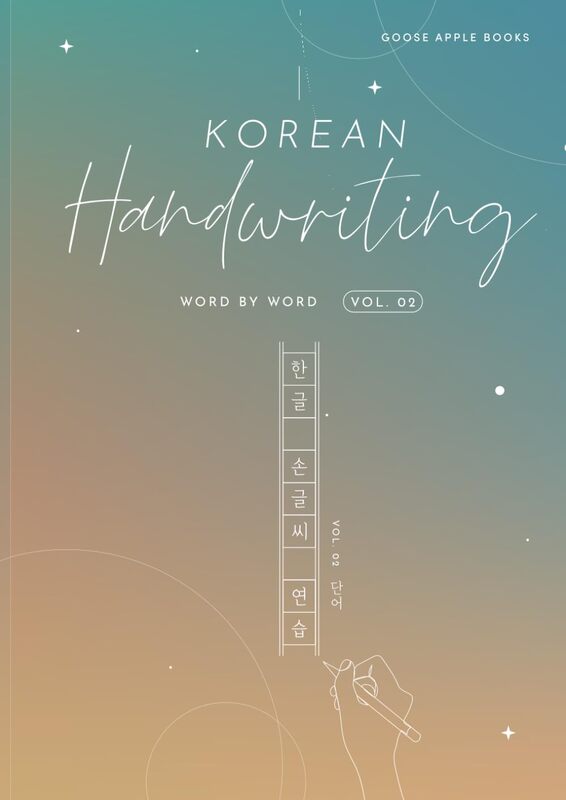پس از انتخاب نوع چاپ با کلیک بر روی کلمه "اضافه به سبد خرید" کتاب های خود را به راحتی خرید نمایید

کتاب آموزش خوشنویسی (خطاطی) کره ای دو Korean Handwriting Word By Word
کتاب آموزش خوشنویسی (خطاطی) کره ای دو Korean Handwriting Word By Word
- انتشارات Gooseapple Books
- شابک 9798988957713
- 220 صفحه
- قطع وزیری
- صفحات کتاب سیاه سفید
دست خط کره ای را تمرین کنید
نوشتن بیش از 250 کلمه واژگانی را در چندین سبک دستخط مختلف از جمله سبک های شکسته تمرین کنید.
در این کتاب شما...
به سبک های مختلف دستخط بنویسید
کلمات واژگان را یاد بگیرید
از خط شکسته کره ای استفاده کنید
دستور استروک ها را تمرین کنید
دست خط خود را بهبود بخشید
این کتاب شش سبک اصلی دست خط، به علاوه یازده سبک تمرینی اضافی را به نمایش می گذارد.
تمام سبک ها فونت های واقعی هستند. بسیاری از آنها بر اساس دستخط افراد واقعی است.
چگونه کار می کند
اول: ترتیب استروک ها
در ابتدای هر بخش، نموداری (مانند بالا) مشاهده خواهید کرد که ترتیب حرکات صحیح کلمه را توضیح می دهد.
هر ضربه به وضوح برچسب گذاری شده است که ترتیب و جهت حرکت آن را نشان می دهد.
همچنین معنای کلمه (در این مورد "گوشت") و و رمانی سازی ("gogi") را خواهید دید.
سپس: سبک
در مرحله بعد، ما کلمه را در شش سبک مختلف دستخط به شما نشان می دهیم و به شما فضایی می دهیم تا خودتان آن را تمرین کنید.
فضایی برای ردیابی کلمه و نوشتن آن آزاد وجود دارد.
ترتیب استروک ها
"ترتیب ضربه" ترتیب و جهت هر خطی است که هر صامت و مصوت را تشکیل می دهد. هر کاراکتر حداقل یک دستور stroke رسمی دارد. یادگیری دستور رسمی استروک ها از همان ابتدا، پایه نوشتاری قوی ایجاد می کند، عادات نوشتن خوبی ایجاد می کند و دست خط شما را طبیعی تر نشان می دهد.
آیا مردم واقعاً از دستور استروک های هانجاها استفاده می کنند؟
بله، آنها انجام می دهند. هنگام یادگیری خواندن و نوشتن در مدرسه، ترتیب استروک های هانجاها به کودکان آموزش داده می شود. سپس این موضوع در سبک های نوشتاری فردی آنها ریشه دوانده است. در حالی که هر شخصی سبک دست خط منحصر به فرد خود را دارد و لازم نیست هر حرف دقیقاً یکسان باشد، معمولاً ترتیب سکته مغزی رعایت می شود.
همانطور که گفته شد، استثناهایی وجود دارد. میانبرهایی وجود دارد که گویشوران بومی برای نوشتن سریعتر از آنها استفاده می کنند، حتی اگر برخلاف دستور رسمی استروک باشد. در این کتاب، هنگامی که دستور رسمی استروک را مرور کردیم، برخی از این میانبرها را نیز به شما نشان خواهیم داد.
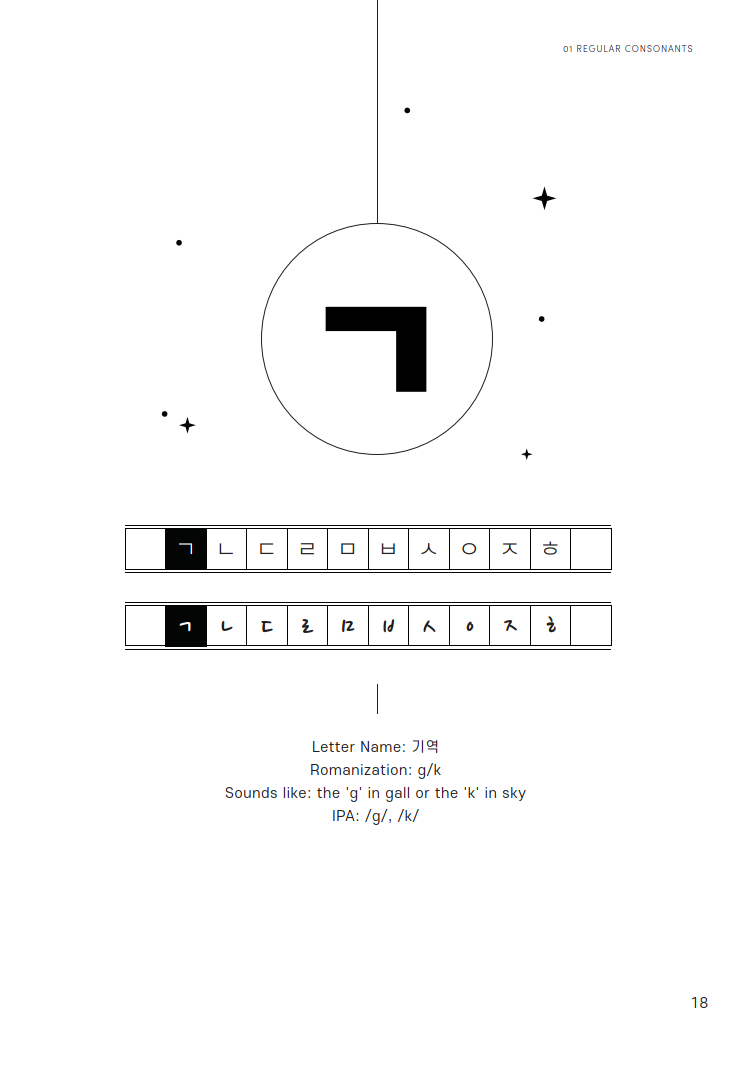
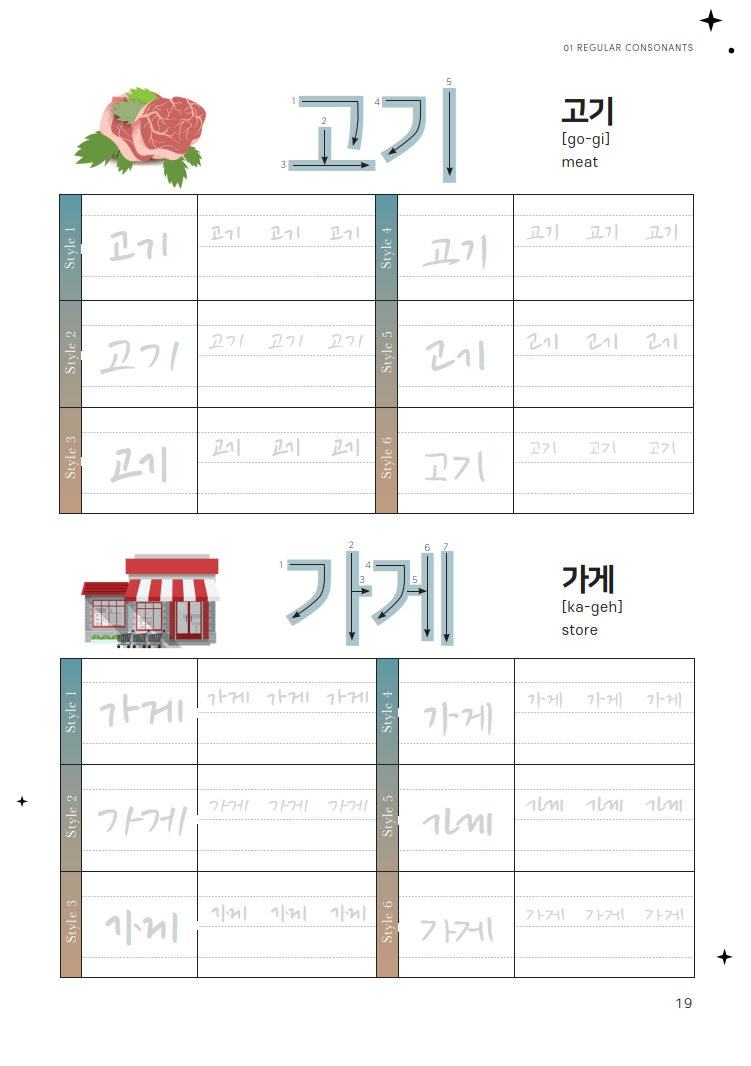
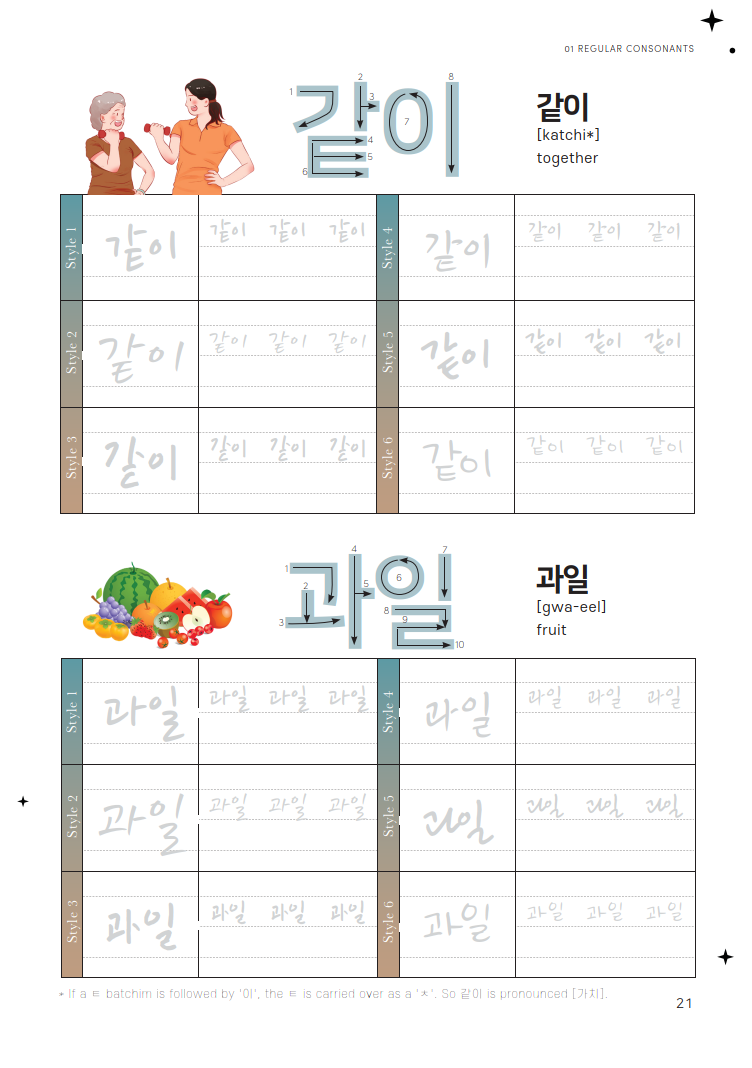
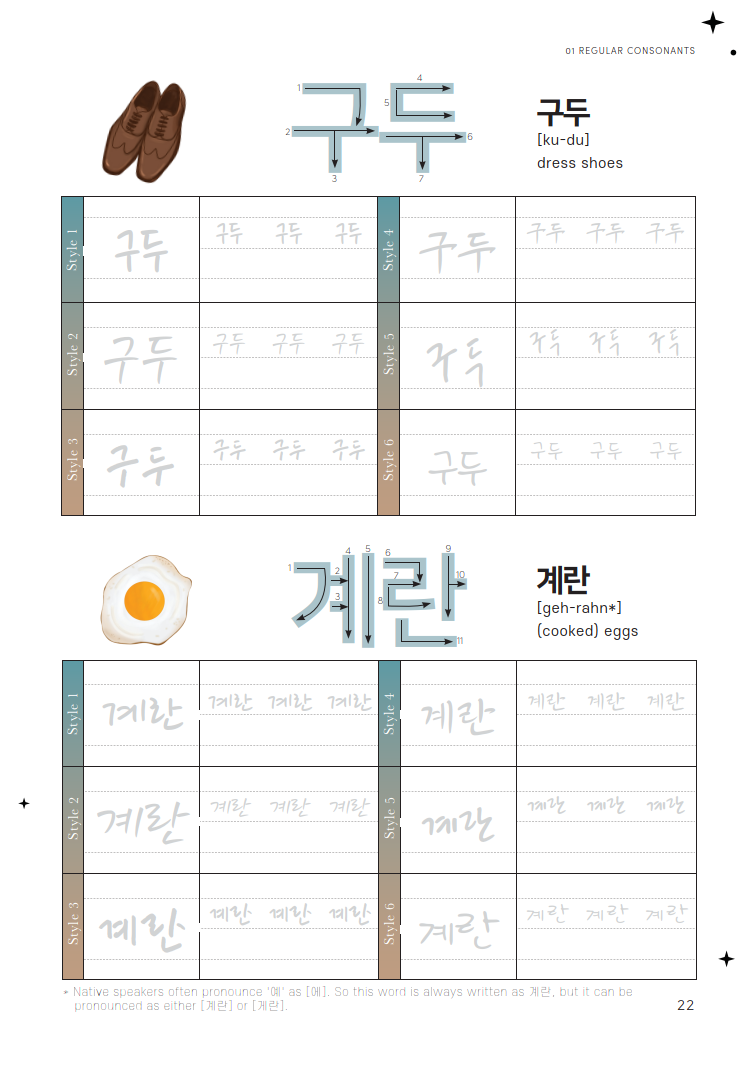
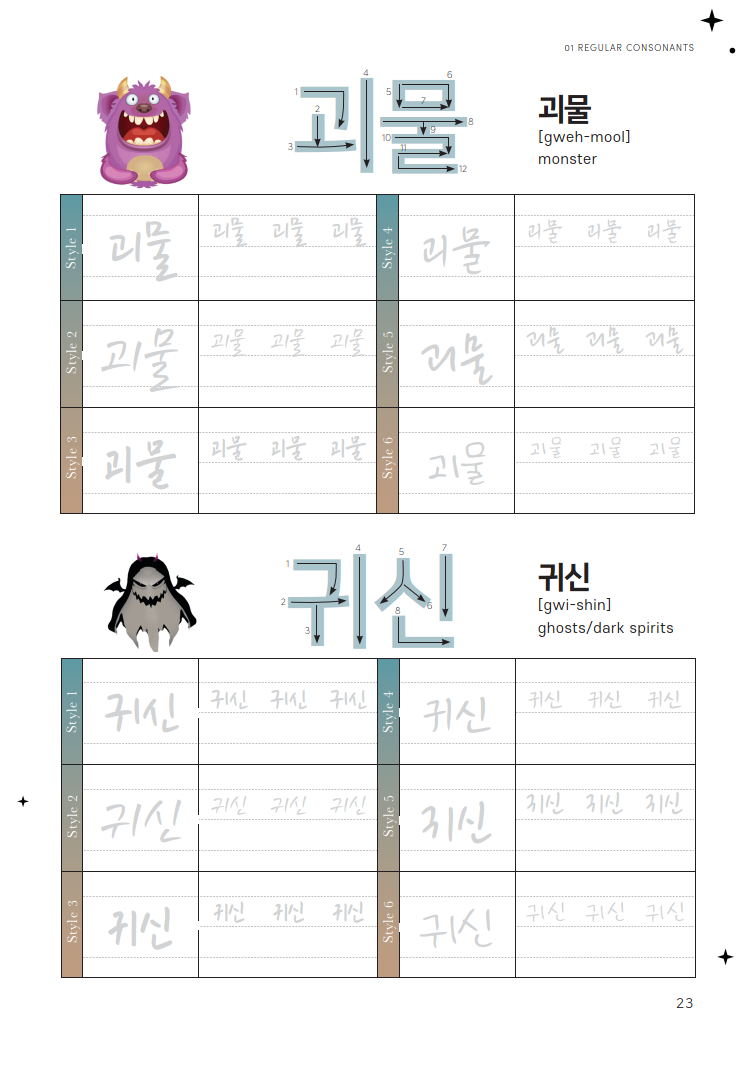
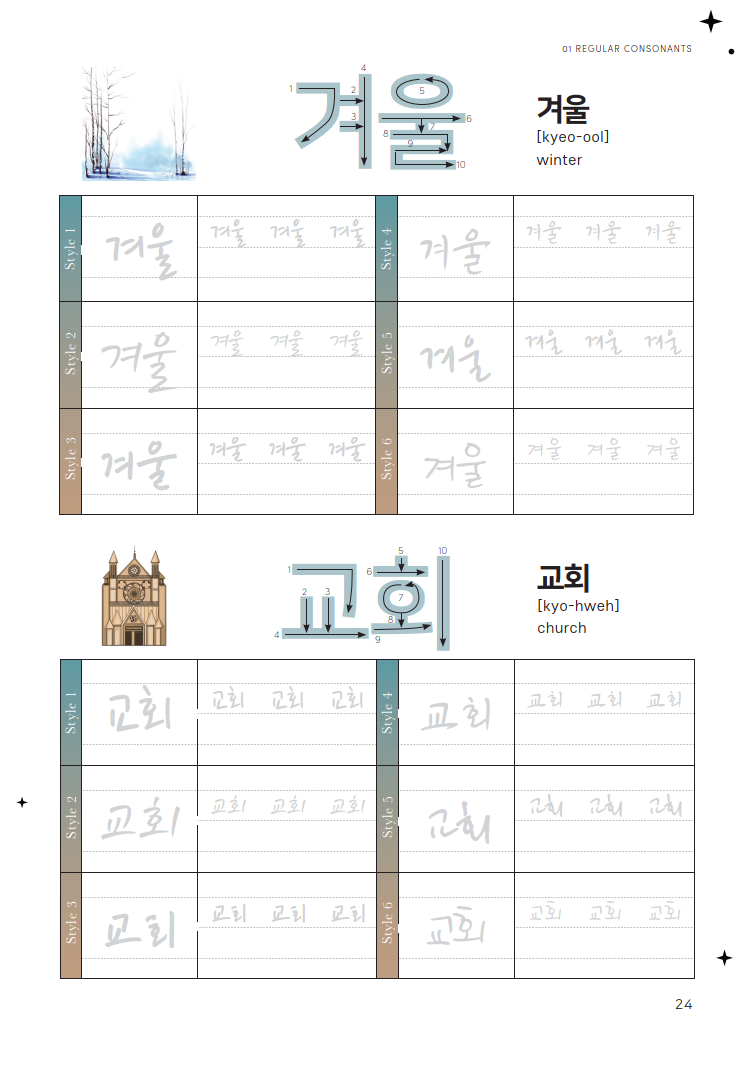
Practice Korean Handwriting
Practice writing over 250 vocabulary words in multiple different handwriting styles, including cursive styles.
In this book you will...
Write in different handwriting styles
Learn vocabulary words
Use Korean cursive
Practice stroke order
Improve your handwriting
This book showcases six core handwriting styles, plus eleven additional practice styles.
All the styles are real fonts. Many of which are based off the handwriting of real people.
How it works
First: Stroke Order
At the start of each section, you'll see a diagram (like above) explaining the proper stroke order for the word.
Each stroke is clearly labeled showing it's order and stroke direction.
You'll also see the meaning of the word (in this case 'meat') and and the romanization ('gogi').
Then: Style
Next, we show you the word in six different handwriting styles and give you space to practice writing it yourself.
There is space to trace the word and write it free-hand.
Korean Stroke Order
'Stroke order' is the order and direction for every line that makes up each consonant and vowel. Each character has at least one official stroke order. Learning the official stroke order from the beginning will establish a strong writing foundation, create good writing habits, and make your handwriting look more natural.
Do people really use stroke order?
Yes, they do. Children are taught the stroke order when they learn to read and write in school. This then becomes ingrained into their individual writing styles. While every person has their own unique handwriting style, and every letter does not have to look exactly the same, generally the stroke order is followed.
That being said, there are exceptions. There are some shortcuts that native speakers use to write more quickly, even if it goes against the official stroke order. In this book, once we've gone over the official stroke order we will show you some of these shortcuts as well.
250+ Vocabulary Words
We hand-picked over two hundred and fifty vocabulary words for this book.
These words were chosen to be fun, useful words that show a wide variety of consonant and vowel combinations to give you maximum writing variety.
Pronunciation Guides
In this book, we give pronunciation guides according to Korean sound-change rules.
What are sound-change rules?
Korean isn't always read as it's written.
"Sound-change rules" refer to how the pronunciation of Korean words can differ from how they are written.
For example, the rule of re-syllabification means that a word like '얼음' (ice) is pronounced [어름].
And the rule of tensification means that a word like '맥주' (beer) is pronounced [맥쭈].
In this book, you learn sound-change rules in context as you learn vocabulary words.
Native Speaker Tips
Although every language has rules, there are always exceptions.
When it comes to pronunciation, sometimes native speakers follow their own rules.
For example, even though 'cafe' is always written as '카페', native speakers always pronounce it as '까페.'
We share these insider tips in this book!
Black-and-white vs Color
Please note that the paperback version is printed in black-and-white.

